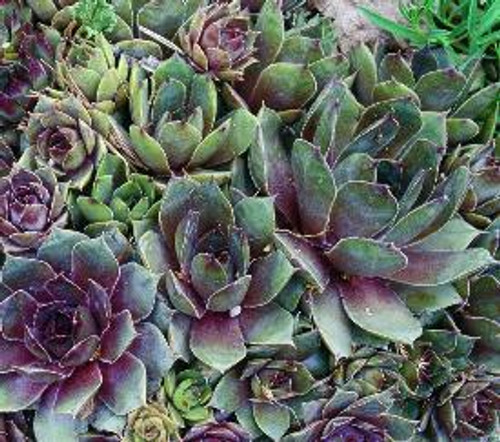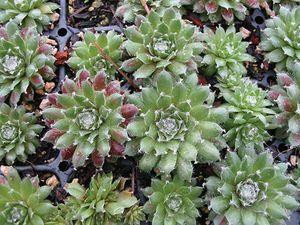Product Description
Sempervivum 'Krebs 2'
Latin translation: Semper means forever and vivo means live.
Which is why Grandma called them 'live forevers' or 'always living'.
a/k/a: Houseleeks, Hens and Chicks, Desert Bloom 2.
Growth Height: 4 to 6 inches tall, 8-to-12-inch spread.
Zone: 3 to 9.
Full sun.
Sempervivum 'Krebs 2', also known as Desert Bloom Hens and Chicks, is a captivating succulent that forms rosettes of colorful foliage.
It is an excellent addition to rock gardens, containers, and green roofs, adding a touch of whimsy and texture.
- Foliage: The fleshy, pointed leaves form attractive rosettes. The foliage color is dynamic, shifting between green and deep purple-red tones depending on the season. In general, expect the rosettes to exhibit a gray-green base color flushed with pink and purple. This color deepens in winter.
- Flowers: In summer, mature rosettes may produce pink, star-shaped flowers on short stalks. While not the main attraction, the flowers add a charming touch.
- Growth Habit: It is a mat-forming succulent that spreads slowly by producing offsets, or "chicks," around the central rosette ("hen"). This creates a charming and intricate tapestry of rosettes.
- Size: Rosettes typically reach 4-6 inches tall and spread to 10 inches or more wide.
- Hardiness: It is hardy in USDA zones 3-8, tolerating cold winters and hot summers.
- Low Maintenance: It is incredibly low-maintenance and drought-tolerant, making it ideal for gardeners who prefer easy-care plants.
Growing Conditions:
- Sunlight: It thrives in full sun to mostly sun, needing at least 6 hours of direct sunlight per day to maintain its vibrant colors.
- Soil: It prefers well-drained soil, such as sandy or rocky soil. It is crucial to avoid wet or poorly drained conditions, which can lead to root rot.
- Moisture: It is drought-tolerant once established and prefers infrequent watering. Allow the soil to dry completely between waterings.
Uses in the Landscape:
- Rock Gardens: Its drought tolerance and colorful rosettes make it a perfect fit for rock gardens.
- Containers: It thrives in containers, adding texture and interest to patios and decks.
- Green Roofs: Its ability to tolerate dry conditions makes it suitable for green roofs.
- Groundcover: When planted en masse, it can function as a unique and colorful groundcover.
- Edging: It can be used as edging along walkways or borders.
Additional Tips:
- Propagation: It is easy to propagate by separating the "chicks" from the "hen" and planting them.
- Deer and Rabbit Resistance: It is generally deer and rabbit resistant.
- Overwatering: Avoid overwatering, as this can lead to root rot.
- Winter Care: In colder climates, it is beneficial to provide some winter protection, such as a layer of mulch, to prevent frost damage.
Overall, Sempervivum 'Krebs 2' is a captivating and low-maintenance succulent that adds color, texture, and interest to gardens and landscapes. Its dynamic foliage, charming growth habit, and adaptability make it a popular choice for gardeners seeking an easy-care plant that thrives in sunny, well-drained conditions.
Ten (10) plants in 4.5-inch containers per flat (or tray).
Other Details
The most important part of the plant is its root system. Healthy roots are the foundation of a healthy, vibrant plant. The type of plug container used is based on the specific needs of the plants. Perennials offered as bare root traditionally perform better when planted as bare root.Planted in a specialized mix, potted plants have well established root systems. Top growth stage will vary depending on the current life cycle and time of year when shipped. In Winter and early Spring dormant plants may be shipped. Dormant plants may be planted right away, even before the last frost date.
Most bare root varieties are field grown for at least one season, though Hemerocallis and Hosta are grown for two seasons. The bulk of the soil is removed during the harvesting process and the tops of most varieties are trimmed back to the crown. They are graded, packed in shredded aspen or sphagnum moss and stored in freezers until ready to be shipped.
See our Container Sizes and Bare Root Perennials pages for more information.
Plant information and care is provided in the Overview section, Plant Genus Page and general information is provided in the Planting Care & Guides. Additional questions can be asked on each Plant page.
Plant Spacing: Using the maximum mature spread or width of a plant to guide spacing, ensures space to grow to full size. To fill an area sooner, plant them closer together. Just remember, future thinning or transplanting may be needed.
Water: Keep a close eye on newly planted perennials, especially throughout the first growing year. Most early plant loss is due to too much or too little water!






